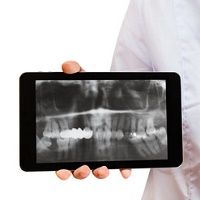Teledentistry Making Waves Across the Country
Telemedicine has become a popular concept in healthcare, but it's still relatively new to dentistry. Experts say the use of video technology can enhance oral health, too.

Telemedicine is becoming fairly widespread in general healthcare. But the use of telehealth technologies in dentistry? That’s something new.
Actually, to Paul Glassman, DDS, MA, MBA, director for the Pacific Center for Special Care at the University of the Pacific Arthur A. Dugoni School of Dentistry, teledentistry is a concept he’s intimately familiar with.
“We've been doing a six-year demonstration project that involves the use of teledentistry,” Glassman says. “But there are very few groups that have done it to the extent that we have.”
The Concept
Glassman explains that the word teledentistry can mean many things. It can be as simple as one dentist emailing an x-ray to another dentist for a second opinion. That’s not new; dentists have been doing that ever since electronic records came on the scene. But Glassman’s six-year demonstration project is more of a virtual dental home system.
The word virtual dental home, Glassman explains, refers to being able to deliver elements such as case management and education, and tracking people to make sure they receive the care they need when they need it. Then making sure they come back in for appointments when they’re needed.
“We’ve been demonstrating that we can deliver those same sets of services through what we’re calling a geographic-distributed telehealth connected team,” Glassman says. “So that’s where teledentistry comes in, but it’s really the bigger picture of being able to deliver a full set of dental services using a telehealth system.”
The results of the demonstration project, which took place in 11 different communities around the state at approximately 50 different sites, was instrumental in persuading the California state legislature to recently pass legislation requiring the state’s Medicaid agency to cover teledentistry services.
But California is not alone. Glassman explains that several states—including Colorado, Oregon, Hawaii, Missouri, Minnesota, and Arizona—have begun demonstrations, or simply took the data from the California demonstration, to propose and/or pass similar legislation. And in November 2015 the American Dental Association issued specific guidelines for dentists interested in delivering their services virtually.
“What’s happening now is this is turning into a wave that’s beginning to spread across the country,” he says. “And I predict that in a few years, many states, and then eventually all states, will recognize that this is a legitimate tool for dentists to be able reach people who are not traditionally getting services at the dental office or dental clinic.”
Financial Benefits
Glassman explains that, based on calculations as a result of the demonstration project, teledentistry is a financially viable practice in which dentists can engage.
“We know exactly how much it costs for the services, because we’ve been doing it with grant support over this demonstration, and we know the kind of services that could be billed for,” Glassman says.
He explains that basic diagnostics and prevention, as well as early intervention services, are often considered loss leaders in dental offices. That will change, he predicts, once dentists begin to bill for those services that can be provided through teledentistry.
“You can do those kinds of procedures with lower reimbursements in a place where the cost of doing them is much lower than in a dental office,” he says. “Then you can actually make a profit on those procedures.”
Glassman further explains that teledentistry affords dentists the ability to reach out to community sites. No longer are services contained within the four physical walls of the practice. For example, some members of the dental team could be at a head start center, a school, or a nursing home, which means they’re operating in a very low-cost environment.
“But overall it’s still one practice,” he says. “Now it becomes feasible for dentists who thought they couldn’t afford to see Medicaid patients because of the low reimbursement fees to provide these services. We’re very confident that once [dentists] get up and running and learn how to use the system, they’ll actually be able to make it pay.”
Lots of Interest
Glassman has been giving courses at California’s annual state dental meetings for the past 18 months and sees much interest in teledentistry as another tool in the dentist’s arsenal.
“Dentists in private practice are still having a bit of a wait-and-see attitude,” he says. “They don’t necessarily want to be in the first wave of people to go out there and do this.”
Trends in dentistry, however, are beginning to replicate the medical field where consolidation is occurring. There are more large groups and fewer dentists going into a solo practice environment.
“Larger groups are going to be in a better position to take this on in a more robust way than individual dentists,” Glassman says. “But there’s still room for individual dentists to do some things. And I’ve been very surprised with how much interest there is and how rapidly things are spreading.”
ACTIVA BioACTIVE Bulk Flow Marks Pulpdent’s First Major Product Release in 4 Years
December 12th 2024Next-generation bulk-fill dental restorative raises the standard of care for bulk-fill procedures by providing natural remineralization support, while also overcoming current bulk-fill limitations.